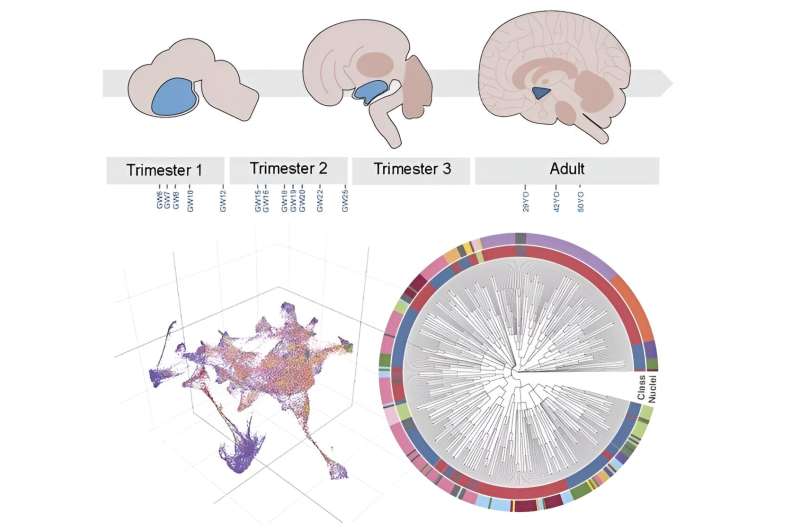
How often do you think about your hypothalamus? Chances are that you never do. As compared to the rest of our brain, it is tiny—just the size of an almond. Yet it is our body’s master control, regulating a myriad of functions including body temperature, circadian rhythm, sleep, blood pressure and blood volume, stress responses, hunger and satiety, arousal, and lactation. Until recently, our understanding of the hypothalamus at cellular resolution came from animal studies.
Now, the cellular complexity of the human hypothalamus has been documented by Columbia researchers Drs. Hannah Glover and Claudia A. Doege in collaboration with Drs. Brian Herb and Seth Ament from the University of Maryland School of Medicine.
Their paper, titled “Single-cell genomics reveals region-specific developmental trajectories underlying neuronal diversity in the human hypothalamus” and published in Science Advances, provides the first complete single-cell census of the hypothalamus throughout development into adulthood.
The study was conducted as part of the Brain Research Through Advancing Innovative Neurotechnologies (BRAIN) initiative, an effort to understand the human brain in unprecedented detail. The team’s analysis of the gene expression profiles of 241,096 hypothalamic cells led to the identification of up to 369 transcriptionally distinct neuronal subtypes representing 10 hypothalamic subregions. Their computational analysis enabled assignment of immature neurons of the developing brain to their respective mature adult cell populations.
This publication also compared the human hypothalamic cell populations to those reported in the mouse hypothalamus and confirmed substantial cell type conservation across both species, though these related cell populations had distinct gene regulatory networks. The investigators further assessed how the developing human hypothalamus compares to other developing brain regions and noted distinct and shared drivers of neuronal maturation across the human forebrain.
Understanding the human hypothalamus at cellular resolution unlocks the capacity for research into the cellular mechanisms underpinning disease. Drs. Glover and Doege are using this atlas to study cellular targets affected in obesity. This research requires knowing which of the hundreds of hypothalamic cells may be affected and may allow the generation of therapeutics to restore function to the affected cell type. Beyond its relevance for obesity research, this atlas will serve the broader scientific community for understanding the cellular and molecular basis of disease affecting other hypothalamic functions.
This paper joins work by 24 other BRAIN Initiative papers published across many journals, whose goal is understanding the human brain in extreme detail.
More information:
Brian R. Herb et al, Single-cell genomics reveals region-specific developmental trajectories underlying neuronal diversity in the human hypothalamus, Science Advances (2023). DOI: 10.1126/sciadv.adf6251
Journal information:
Science Advances
Source: Read Full Article